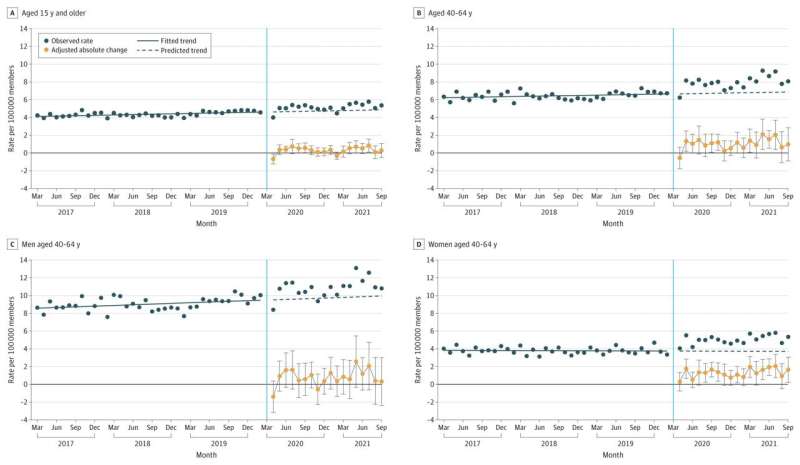This article has been reviewed according to Science X's editorial process and policies. Editors have highlighted the following attributes while ensuring the content's credibility:
fact-checked
peer-reviewed publication
trusted source
proofread
Pandemic drinking hit middle-aged women hardest, study finds

Middle-aged women experienced increases in alcohol-related health complications during the COVID-19 pandemic, according to new research led by a University of Pittsburgh physician-scientist and published today in JAMA Health Forum.
The scientists say the research raises alarm bells indicating the need for immediate public health and clinical interventions to reverse the trends, including urgent communication about the risks of alcohol use.
"Even though alcohol-related deaths are higher among men than women, the rate of change has increased faster among women compared to men over the last decade," said lead author Bryant Shuey, M.D., M.P.H., assistant professor of medicine and internal medicine physician at UPMC. "We anticipated finding some increase in hospitalizations for alcohol-related complications among women. We didn't realize it would be this stark."
Data for the study came from a deidentified commercial insurance database and included over 14 million patients aged 15 and older. The researchers looked at monthly rates of alcohol-related complications requiring urgent medical care, which included alcohol-related liver diseases, such as cirrhosis or hepatitis, as well as alcohol withdrawal and alcohol-related heart disease, among others.
Researchers then analyzed and compared the monthly rate of hospital admissions for alcohol-related complications during the pandemic to what would have been expected based on the pre-pandemic trend. Middle-aged women's rate of hospital admissions for alcohol-related complications was higher than expected in 10 of the 18 months following the start of the pandemic in the U.S., compared to four of the 18 months when looking at all ages and genders.
Middle-aged women experienced higher-than-expected rates of hospital admissions for alcohol-related liver diseases in 16 of the 18 pandemic months. To the researchers, this was alarming, given that alcohol-related liver disease is the leading underlying cause of alcohol-related deaths in the US.
The authors were not able to determine the exact reasons for these increases, though previous research has shown U.S. women increased alcohol use more than men over the last decade. While men drink alcohol more often and in larger quantities than women, alcohol use has stayed level or even decreased among men over the last decade.
An additional uptick in alcohol use that women experienced during the pandemic may have tipped new or worsening alcohol-related health problems over the edge, leading to hospitalization, the researchers report. Difficulty in accessing outpatient health care during the pandemic and relaxed alcohol policies, such as alcohol delivery, could also have contributed to increased rates of high-acuity episodes.
"We know that reducing the amount of alcohol one drinks can improve health, and we have tools at our disposal to help people drink less," said Shuey. "There are effective treatments for alcohol addiction, ranging from behavioral interventions to medications. There are also effective policies for reducing harmful alcohol use, such as increasing alcohol taxes and limiting advertising."
Findings also suggest that similar increases in alcohol-related complications may have affected males, but further research is needed.
More information: Bryant Shuey et al, High-Acuity Alcohol-Related Complications During the COVID-19 Pandemic, JAMA Health Forum (2024). DOI: 10.1001/jamahealthforum.2024.0501. jamanetwork.com/journals/jama- … /fullarticle/2817439





















